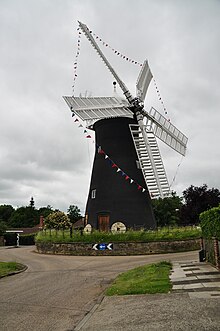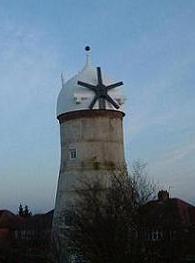Holgate Windmill
 From Wikipedia - Reading time: 9 min
From Wikipedia - Reading time: 9 min
| Holgate Mill, York | |
|---|---|
 The mill in June 2014 | |
 | |
| Origin | |
| Mill name | Holgate Mill |
| Grid reference | SE 5841 5148 |
| Coordinates | 53°57′22″N 1°06′41″W / 53.9561°N 1.1113°W |
| Operator(s) | Holgate Windmill Preservation Society |
| Year built | 1770 |
| Information | |
| Purpose | Corn mill |
| Type | Tower mill |
| Storeys | Five storeys |
| No. of sails | Five sails |
| Type of sails | Double Patent sails |
| Windshaft | Cast iron |
| Winding | Fantail |
| Fantail blades | Eight blades |
| Auxiliary power | Electric Motor (1930) |
| No. of pairs of millstones | Four Pairs |
| Other information | Restored and working |
Holgate Windmill is a tower mill at Holgate in York, North Yorkshire, England which has been restored to working order.
History
[edit]Holgate tower windmill was built in 1770 of brickstones by its first owner and miller George Waud. He, his son and grandson ran the mill until 1851, and a dwelling-house was erected around the same time.[1] The mill was originally fitted with five Roller Reefing sails although these were later replaced by Double Patent sails.[2] In 1841, the mill was described as having three pairs of French Burr millstones, two dressing machines and five Patent sails.[3] A fourth pair of stones had been added by 1858.[4]
In 1859 a new granary was built, and a steam engine installed to make the mill more profitable. An extra floor was also built to raise the mill to its present height.
In 1930, a large electric motor was installed to replace the steam engine, chimney and boiler house, which were pulled down. After some storm damage (sails backwinded), the mill had to stop grinding under wind power, and the City Council had the sails and the fantail removed. Milling with the electric motor ceased entirely in 1933. In 1939, a new white-painted cap was built onto the milltower. The mill's last known miller was Thomas Mollet; Eliza Gutch and her family were the last known owners of the mill.
The mill was given Grade II listed building status in 1954.[5] In 1955 further cap repairs were made, and its five stocks (whips, sailbacks) were removed in 1956.
In 2001 the Holgate Preservation Society was formed, and the mill's doors were opened to the public in 2005 for the first time after 70 years. Planning for the restoration of the mill began in 2003, and the restoration started in 2006. Scaffolding was erected around the mill to remove the external black paint and render. Electricity supply was installed, and new oak doors and windows were built in. A new lime render was applied to the outer walls. In autumn 2006, the old cap with shears, brake wheel and iron cross was removed by crane, along with the old curb ring which carried the cap. The iron ring was broken and the supporting wooden frame was rotten. In 2007, most of the external renovation works were completed, a newly manufactured curb ring was lifted in, the scaffolding was removed, and the mill's open top was sealed against rain.
A new white cap with ball finial, brake wheel, windshaft, shears and fivefold iron cross including the fantail rack was craned onto the mill on 28 November 2009.[6] Five new sails were fitted on 20 December 2011;[7] the following year, shutters were added and in April the sails turned, powered by the wind for the first time since 1930. The official opening of the now restored mill took place on 23 June 2012.[8]
The mill typically works one day a week producing around 75 kilograms (165 lb) of wholemeal and spelt flour. During the Covid-19 outbreak, an upsurge in demand has seen an increase to 400 kilograms (880 lb) per week.[9]
-
June 2009, prior to external restoration
-
November 2009 when the new white cap was added
-
December 2011, just after restoration of the sails, but before the shutters had been installed
-
The fully restored mill in July 2013
Description
[edit]Holgate Mill is a five-storey tower mill including ground storey. The storeys are: meal floor, stones floor, bin floor, dust floor, and cap. The mill originally had a black ogee cap, since 1939[10] a white cap which was winded by a fantail. There were five Double Patent sails carried on a cast-iron windshaft and mounted on a cross in the Lincolnshire style (Lincolnshire cross).[1] The mill drove four pairs of millstones, three pairs of French Burrs and one pair of Peaks.[2]
Millers
[edit]
- George Waud 1770–92[1][11]
- George Waud Jr 1792–1811[1][11]
- George Waud grandson 1811-1851 (John Musham mortgagee from 1841, then mill owner from 1851)[1][5][11]
- John Thackwray 1851–55 (Joseph Peart mill owner from 1855)[11][12]
- George & Joseph Chapman (brothers) 1858–60[4][11]
- William Bean Horseman 1860–66[11]
- Joseph Chapman 1866–1896[11]
- Charles Chapman (son of Joseph) 1896-1902[11]
- Herbert Warters 1902–22 (Gutch family owners from approx 1902)[11][13]
- Thomas Mollett 1922–33[1][11][13]
See also
[edit]References
[edit]- ^ a b c d e f "History and Background of Holgate Windmill". Holgate Windmill Preservation Society. Archived from the original on 24 July 2008. Retrieved 19 June 2009.
- ^ a b "Design and Structure of the windmill". Holgate Windmill Preservation Society. Archived from the original on 7 July 2010. Retrieved 19 June 2009.
- ^ "Yorkshire Gazette, 6 March 1841". Archived from the original on 7 July 2010. Retrieved 19 June 2009.
- ^ a b "Yorkshire Gazette, 7 August 1858". Archived from the original on 7 July 2010. Retrieved 19 June 2009.
- ^ a b Historic England. "Details from listed building database (1256229)". National Heritage List for England. Retrieved 20 June 2009.
- ^ "Cap for Holgate windmill ready to lift". Windmill World. Retrieved 16 October 2009.
- ^ "Full sail for restored York windmill". BBC News Online. 20 December 2011. Retrieved 22 December 2011.
- ^ Video of official opening.
- ^ Pantry, Lindsay (9 May 2019). "Serendipity as historic mill feeds its community once again". The Yorkshire Post. Retrieved 9 May 2020.
- ^ "Cap Restoration 1939". Archived from the original on 7 July 2010. Retrieved 28 January 2010.
- ^ a b c d e f g h i j Holgate Mill, York Press from 20 October 2006
- ^ "Yorkshire Gazette, 14 April 1855". Archived from the original on 7 July 2010. Retrieved 19 June 2009.
- ^ a b Holgate Windmill timeline
 KSF
KSF


